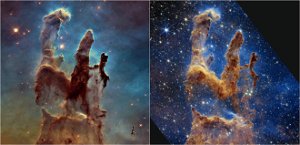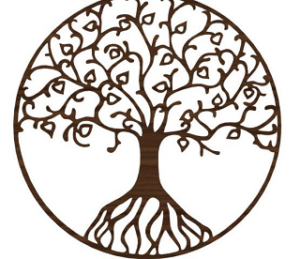
Posts Tagged ‘Noosfera’
Where is the divine locus
Of course the divine locus is anti-spatial and temporal, even modern quantum physics developed the theory of the space-time dimension as the only dimension and where there are folds in time, but it is likely that physics will still make discoveries greater than wormholes. , accelerated space travel dimensions and will change our cosmic view of space.
quantum physics developed the theory of the space-time dimension as the only dimension and where there are folds in time, but it is likely that physics will still make discoveries greater than wormholes. , accelerated space travel dimensions and will change our cosmic view of space.
The latest discoveries by James Webb, the telescope that looks at the origin of creation, already sees in what astronomers call the pillars of creation, the new images (10/19) show formations that look like rocks, but which are clouds of gas and dust of astronomical dimensions, where stars and celestial bodies are formed, in a kind of nursery.
The new image, using James Webb’s infrared resource [and it is possible to better observe the dust in this region of star formation (Image from NASA above), improving the image on the left of 2014 from the Hubble telescope, the image on the right being the image by James Webb.
In terms of the eschatological cosmovision, the one that studies the beginning and end of humanity, it is possible to imagine that through a “time warp”, we are still stuck in Einstein’s physics, this cloud forms and starts a development of stars, supernovae and galaxies in the universe.
The divine plan is even broader, since the time of Jesus, men wanted to know when the “kingdom of God” would be formed, an earthly dimension in which our human condition would be elevated to a level of happiness and prosperity that would reach everyone. , “where milk and honey flow”, but the master’s answer was not very pleasing to those who wanted something more tangible.
The reading in John 1:20-21 says they wanted to know the moment of this “kingdom” and Jesus replied: “the kingdom of God does not come ostensibly, nor can it be said ‘is here or ‘is there, because the kingdom of God is among you”, that is, it must take place among men, so there will still be many changes in the human and earthly dimension until this stage.
And the passage clearly says that before this the son of man (Jesus who is a presence of God among us said above), will have to be rejected and will suffer much.
Thus, it is necessary to find spaces of solidarity and fraternity among men where these seeds of full life are developed, men understand each other and look with love for their fellow man, without contempt or exclusion.
So this kingdom is near where there is love and brotherhood and far away where there is greed and exclusion.
A simbologia das árvores na bíblia
A maioria das mitologias e religiões incorporam a ideia da “árvore da vida” como um elemento central de sua simbologia, a árvore como centro da vida e de onde ela irradia é um simbolismo forte e quase universal.
um elemento central de sua simbologia, a árvore como centro da vida e de onde ela irradia é um simbolismo forte e quase universal.
O símbolo adâmico, onde Adão e Eva podiam comer o fruto de todas árvores, “E ordenou o SENHOR Deus ao homem, dizendo: De toda a árvore do jardim comerás livremente,” (Gen 2:16), com exceção do fruto da árvore da vida.
Na simbologia bíblica o cedro-do-líbano, por sua altura que pode chegar a 30 metros e sua largura que pode chegar a 15 metros é símbolo de poder, majestade, grandeza e beleza, isto pode ser visto no texto de Isaías (Is 2.13), Ezequiel (Ez 17.3,22,23 – 31. a 18) e Zacarias (11.1,2).
A figueira tem uma característica que a torna um símbolo bíblico de uma vida que está seca mas pode dar fruto, está presente no antigo testamento (Provérbios 27:18), no novo testamento onde Zaqueu subiu para ver Jesus (Lc 19:4), e também dá a curiosa passagem que Jesus estava com fome indo a Betânia vê uma figueira com folhas, e apesar de não ser tempo de frutos, não encontra nada e amaldiçoa a árvore (Mc 11:12-14).
Em compensação há o pedido dos agricultores para cavar e adubar a figueira que não dava frutos (Lc 13,1-9) no contexto em que Jesus explica que nem os galileus que Pilatos matou e misturou ao sangue oferecido aos seus deuses romanos, e também os que morreram na queda da Torre de Siloé, dizendo que não morreram por serem maus e a explicação é que eles deveriam “dar frutos”.
Porém a árvore a qual Jesus se compara é a videira, em João 15:1 afirma: “eu sou a videira verdadeira, e meu Pai é o agricultor”, explica que os discípulos são os ramos e que para dar frutos sofrem a poda, para dar mais frutos ainda.
A videira não dá boa lenha nem sombra, e os ramos só podem produzir estando ligados ao tronco, dito assim: “Eu sou a videira e vós os ramos. Aquele que permanece em mim, e eu nele, esse produz muito fruto, porque sem mim nada podeis fazer” (Jo 15,5).
Site e blog atualizados
Após um esforço que envolveu a empresa que hospeda o site (combr) e um amigo que me auxilia na manutenção do blog a versão do WordPress 5.7.1. foi atualizada, em breve algumas mudanças no design e ferramentas também serão modificados.
que me auxilia na manutenção do blog a versão do WordPress 5.7.1. foi atualizada, em breve algumas mudanças no design e ferramentas também serão modificados.
Como dissemos no início da manutenção, algumas mensagens estranhas iriam aparecer, mas decidimos manter o blog no ar provendo alguns conteúdos porque percebemos que o processo podia demorar um pouco.
Voltamos a postagem diária, exceto sábados e domingos, e agradecemos aqueles que nos leem e acompanham.
Chardin’s clearing
The word is in Heidegger’s philosophy, but studying German etymology we come to the word Lichtung, where the meaning is of a clearing in the forest, while Licht is the word for light, that is, to remove hidden things and unveil them so that the truth come up.
etymology we come to the word Lichtung, where the meaning is of a clearing in the forest, while Licht is the word for light, that is, to remove hidden things and unveil them so that the truth come up.
In Chardin it means looking at the Cosmos in its complexity and acquiring awareness of an immense and infinite universe in which Alpha (origin) and Omega (end) are present, but with the meaning of giving the complexity-consciousness the necessary light to understand the life process.
It starts with the Human Phenomenon and will be clearer in your book “The divine environment” where he talks about the inner life, not in the intimate sense, but in the sense of reconnecting it to God and to others.
Explaining better by reading Chardin: “In their effort towards mystical life, men often gave in to the illusion of brutally opposing spirit and flesh, body and soul, as if it were good and evil. from certain current expressions, this Manichaean tendency was never approved by the church… “(p. 117), but it is resistant and is always present in everyday religious discourse,. the purely economic and political views of religion led to this state.
For this reason Chardin will insist on an “interior” life, one capable of achieving divine designs within human realities, hence “the divine environment”.
But what is the divine means, is that permanent tension: “slowly accumulated between Humanity and God will reach the limits fixed by the possibilities of the World, and then it will be the end” (p. 177), we must hope not as a catastrophe or a great sign, but an ´outgoing´ for the world that is heading for a civilizational crisis, and to which we must collaborate that it passes, with all our Christian forces, of other religions or of “good faith”, without fear of the world,
The light came into the world, says the evangelist João (1,20-21), but those who do evil reject it, “But those who act according to the truth, approach the light, so that their actions are carried out. in God ”, and thus carry out our actions within the“ divine environment ”where everything is connected to the Cosmos.
CHARDIN, Teilhard. O meio divino: ensaio sobre a vida interior. Lisboa: Editorial Presença, s/d.
The human future and unity
Several points of Teilhard Chardin’s thought coincide with the new  theological currents that arise in the religious milieu, especially in the Catholic, but Chardin opened his spirit even more when he practically migrated to China, the environment and Eastern philosophy influenced him.
theological currents that arise in the religious milieu, especially in the Catholic, but Chardin opened his spirit even more when he practically migrated to China, the environment and Eastern philosophy influenced him.
His originality is as much in the evolutionary synthesis of his vision, as in several aspects of a futuristic eschatology that covers the entire Cosmos and whose convergence he calls “Omega”, which is an individualized but not isolated force, different from authors who stop at criticism to the problem of contemporary individualism without understanding that individuation tends to this “Omega point” futuristic, evolution chases.
Some authors understand the Cristosphere as a recapitulation of everything, say some theologians, but the evolutionary process culminates like man, but it does not end with man, the universe, man and woman, the historical trajectory, everything responds to a path for the Parusia of the Lord, and it is inevitable and the highlight of a Christian eschatology, and to deny the end of everything is to deny the eschatological process or at least not fully understand it.
So says U. Zilles about Chardin: “It is the risen Christ, who incorporates the world and humanity into the Mystical Body, in the finish of the Total Christ”, so this means that the Earth and the Universe will be prepared for the Parusia of the Lord (or the return of Christ), in full eschatology.
As a force of individualized action Omega is not subject to time and space (current physics has already shown these concepts as not absolute), so properties such as autonomy, actuality, irreversibility and transcendence are not subject to temporal actions, but to Omega.
Chardin explains that the multiple ecological, physiological, psychological factors that bring living beings together, especially human beings, and that especially environmental, physical and spiritual conditions are extension and expression, at a level of complexity-consciousness energies that they can bring Omega closer together.
Let it be said in passing that everything is in the various passages of Jesus (approaching the humble, dialogue with public sinners and finally handing over to the hands of the bad religious and politicians of his time), what Chardin wants to say is even further, that if we understand complexity-awareness, we help humanity to make a leap in quality that brings us closer to the Omega point.
Chardin’s phenomenology is radical because Creation is the beginning of phenomena, and the divine always operates in it, present in the actions and laws that govern organisms and living beings: God is at birth and in growth and at the end of all things, […] It does not mix or be confused with the participatory that sustains, animates and connects.” (Rideu, p. 271).
Thus, looking at the phenomena of the universe is looking at greatness and human development. It is not by chance that scientists look for comets, stars and stars from all over the cosmos for signs of life and the origin of life. Creator.
Zilles, U. (2001) Pierre Teilhard de Chardin: Fé e Ciência (Chardin: faith and science). EDIPUCRS, pag. 59-60.
Rideau, E. (1965) O pensamento de Chardin (Teilhard de Chardin’s thought), Ed. Duas Cidades, 1965, p. 271.
A planetary tele-participation
This whole process excluded people and cultures, Edgar Morin and Anne B. Kern to analyze the emergence of Earth – Homeland, remember that the invasion of China by Japan in 1931 was ignored by Europe , the “Chaco War between Bolivia and Argentina (1932-1935) was another planet ” (p. 38 ) , and ” only after 1950 is that the Korean War , the Vietnam and ( with the generalization of television) the Middle East have become close. ” (p. 38) .
and Anne B. Kern to analyze the emergence of Earth – Homeland, remember that the invasion of China by Japan in 1931 was ignored by Europe , the “Chaco War between Bolivia and Argentina (1932-1935) was another planet ” (p. 38 ) , and ” only after 1950 is that the Korean War , the Vietnam and ( with the generalization of television) the Middle East have become close. ” (p. 38) .
It is then that world events begin to seem that occur in our backyard , the authors cite Kennedy’s assassination in Dallas in 1963 , the arrival of Sadat to Jerusalem and his assassination in 1981 , the attack on the Pope in Rome , the assassination of Indira Gandhi and her son Rhajiv and murder of Mohammed Boudiaf the House of Culture of Anaba , and they add ” if only for the duration of a flash human emotion wells up to the point we take our clothes , our mite to international aid organizations to humanitarian missions.” (p. 39) .
It is only when people see is that the medical and food aid arrive , but when the authors wrote the book ( in 2000 ) said they still ” we felt for planetary flashes ” (p. 39), is now with videos and simultaneous photos can say the same ?
Tsunamis , hurricanes , floods seem to occur in distant places make us feel more part of the people so far away , and bring us the “feeling of belonging to the same community of destiny , now the Earth community ” (p. 39)
The authors finish Chapter 1 , despite the concern with “agonizing convulsions” claim that ” although there is not now a community of fate , there is still no common awareness of this Schicksalgemeinschaft . ” (P. 41 ) (in certain situations that communities share the destination : shipwrecked people trapped in a mine, etc. and it can now become a common feeling to the entire planet ) and here I include the noosphere, “the spirit” planetarium..
The authors also analyze the planetary identity (Chapter 2) and the problems of planetary distress (Chapter 3), but I’m optimistic I think it is possible now that we have a media mirror network , see the fact that we have to face and decide how it her pleasant creating a new nation – World´s peoples, cultures, biosphere and noosphere shared by all.
Post 1000 and new themes
Reached in late 2013, precisely on the last day of the year posting number 1000,  although it is only a number had already thought of a new theme , although it is the same, but will flee more of the technical aspects to address the social and cultural aspects .
although it is only a number had already thought of a new theme , although it is the same, but will flee more of the technical aspects to address the social and cultural aspects .
Around the blog is what we call philosophy and Noosphere, but could also be Culture and Theology, without confusing them with Ideology and Religiosity, yet each can assume this connotation in certain contexts .
In these four years of blog try to show the technological changes that occurred throughout the planet, from political news as the Arab spring and the moves in the network to gadgets that create new mechanisms of interaction and communication that take place worldwide and involve repositioning cultural and social conditions in the planet’s inhabitants .
Technology when it reaches a level of full penetration in culture, turns herself in culture, in this case the ciberizados devices, is what was called Cyberculture.
We now want these devices to reach what we call ” calm technology “, ie, their impact assimilated into the culture, discusses them and develop them within the objective and subjective being-in-the-world aspects, and the relationship with its existence .
But we could not fail to address the aspects of his essence , ie the being-as-being, which was called in philosophy ontology, already discussed several times here and what refers to a subjective , spiritual sphere layer surrounding the culture and existence , which is the noosphere , the sphere of noon (spirit, mind or cultural mentality).
Welcome to 2014 , walk together in our lifetime on this planet .
The Book Thief
I made the purpose of reading this book to a friend, housewife, who asked me who only read books  “academic” and the result was surprising.
“academic” and the result was surprising.
The beginning seemed to me that the story of Liesel Meminger although interestingly told by a friendly narrator , drew a morbid journey in which you insert a little thief of books , a fondness which Death to Liesel ‘s track from 1939 to 1943 .
Traits of a survivor are outlined : the Communist mother, persecuted by the Nazis , sends Liesel and her brother for the poor suburb of a German town where a couple is willing to adopt them for cash .
But the boy died on the way and is buried by a digger dropping a book in the snow , which will be the first of several that girl stealing over the years and this book will be the link to your family.
The adoptive father is a painter of wall debonair who teaches him to read , is Nazi period and many books are burned, but she steals the reading of the mayor or the city library.
This virtual – reality created around Hitler and the Second World War , the girl attends Death , with some perplexity of human violence , but manages to give a light and fun tone to the narrative in this harsh reality of lost childhood and the cruelty of the world war.
But the book has a curious dying and living , hence my inevitable connection to Heidegger and to the present day , with dark clouds hovering over the cultural and society .
Networks, yes we are talking about people
We did the two previous posts to do a quick analysis of what is , in my view, the most profound and consistent critic of the Internet and Web, Jaron Lanier , co -founder of Wired and author of “You are not gadget” (I start with the translation error em portuguese Welcome to the future : a humanistic vision the future of technology) .
the most profound and consistent critic of the Internet and Web, Jaron Lanier , co -founder of Wired and author of “You are not gadget” (I start with the translation error em portuguese Welcome to the future : a humanistic vision the future of technology) .
The center of criticism of Lanier can be found on page 92 , stating : “History attests that collectivist ideals can grow and become a large social scale ” , to then cite fascists and communists who began a small number of revolutionaries , ie , for it is what is happening with the digital world .
But networks have always existed in human history , and all the critics think that the network is a network tool on the Web (which is just a web application ) and not stop to think that networks are people , and that the global visibility through an electronic and digital , social media but this may have several tools : twitter , facebook and now Whatsapp is falling in love , at least the young.
Thus the network would be for him an oscillation between ciberfascistas and cibercomunistas , maybe both , but his real ideology appears to say that there is a ” ideology of violation ” referring to Wikipedia and open source , but slipped in authoritarian culture by stating : ” the multitude of free culture believes that human behavior can be modified only by involuntary means ” ( page 143 ) and then immediately shows its neoliberal belief ” they do not believe much in free agency or personhood , “where she was in the cultural industry ?
But leave your questions and more interesting questions for the end : “Is there a way to understand our story to explain what a word is and how one can know c’rebro a word ? (page 213 ) , ” there is a relationship between smell and language, this famous product of the human cerebral cortex ? ” and finally a key question ” in Chapter 2 , I argued that the following question may never be scientifically : the nature awareness ? “And states categorically : ” No experiment can demonstrate that consciousness exists “(p. 223 ) , that is the culture of objectivist author separating subject from object , almost to the point of denying (at least empirically ) the existence of consciousness , reply with two experiments which he himself proposes , the phrase :
The lngyagi ish onz coissa stranya . ( p. 218 )
Another is the experiment V. S. Ramachandran , a neuroscientist at the University of California at San Diego , called Experiment Rama, who is to decide what is kiki and yaws (page 224 ) using as a ” metaphor ” two figures , one spiny and one soft ( the words do not exist in most the known languages ) , is one of two figures puts thorns and other softer .
Would get better if he started the conversation poraí , needed to destroy the technology first and gives the impression of poor objectivity and subjectivity bad , and it’s tongue is what ?
Applications used in World Youth Journey
The event brings together young people from  around the world connected to the Catholic Church, is a week to be done, has special application for use by tourists who come to Rio de Janeiro.
around the world connected to the Catholic Church, is a week to be done, has special application for use by tourists who come to Rio de Janeiro.
A specific application was created by a young Campinas and made available by the Archdiocese of the region, called iJuventude, content, music, and all the events related to Journey “on the palm,” to facilitate the movement, but only being available for android devices and Apple.
Previously New Song Community had launched an application Follow the Cross.
Another application has been launched by the Municipal Tourism Rio de Janeiro in addition to containing information about Journey, suggestions of the best routes, places to be visited and tourist information in Rio de Janeiro.
The free download of the app in iOS and Android operating system, is also available in the app store WYD World Youth Day and Google Play as jmjrio2013, available in English, Portuguese and Spanish.
Also on the official guide Rio de Janeiro the application can be found.

